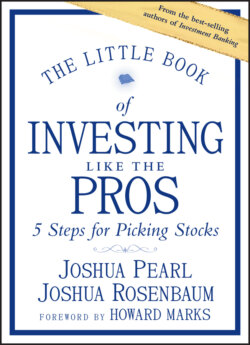Читать книгу The Little Book of Investing Like the Pros - Joshua Rosenbaum - Страница 21
Step IV: Valuation & Catalysts
ОглавлениеIn Step IV, we turn our attention to valuation, arguably the core component of the investment process. Here you need to determine what the company is worth, whether it is cheap or expensive, and whether there are any “catalysts” for revaluation. Even a stock that passes the business and financial test with flying colors may fail the valuation test. In other words, it may be too expensive at current levels to produce an attractive return. This is the trap of “good company, bad stock.”
In this chapter, we teach you how to perform the key valuation methodologies at the core of any stock analysis. These include market and intrinsic valuation techniques, such as comparable companies and discounted cash flow analysis. We also discuss M&A valuation approaches, including precedent transactions, leveraged buyout analysis, and accretion/(dilution). More nuanced techniques, such as sum-of-the-parts and net asset value, are then introduced to round out your skill set.
Some combination of these tools is used to determine your price target (PT) for a given stock, which is critical for making your ultimate investment decision. Further, we review common catalysts that can unlock the hidden value in a stock and trigger a revaluation. Catalysts may be internally-driven, as part of an evolving management strategy, or external, triggered by shareholder activism or regulatory changes. Key catalysts include earnings beats, M&A, capital return, refinancings, CEO changes, and new product launches.
